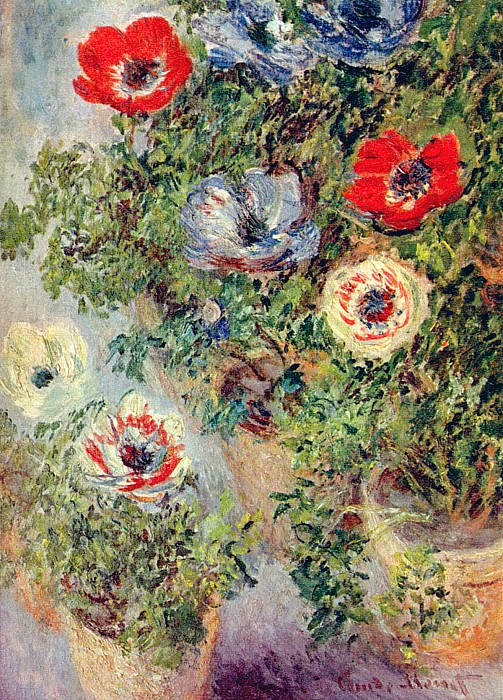Stilll Life with Anemones Claude Oscar Monet (1840-1926)
Claude Oscar Monet – Stilll Life with Anemones
Edit attribution
Download full size: 1200×1670 px (0,3 Mb)
Painter: Claude Oscar Monet
Monet was a French Impressionist, like all his colleagues in the genre, who sought to capture the reality around him as fully as possible and transfer it to paper, for time is constantly flowing away and it is not in human power to catch it, unless with a brush and paints. He began, however, with caricatures - he gained early fame with them and was very popular in his city. This period ended by happy coincidence - he met a mature artist (originally Monet disliked him in absentia) who showed Monet nature, directed his keen eye, attention to detail, ability to quickly grasp and faithful hand to capture something worthwhile.
Description of Claude Monet’s painting "Anemones"
Monet was a French Impressionist, like all his colleagues in the genre, who sought to capture the reality around him as fully as possible and transfer it to paper, for time is constantly flowing away and it is not in human power to catch it, unless with a brush and paints.
He began, however, with caricatures - he gained early fame with them and was very popular in his city. This period ended by happy coincidence - he met a mature artist (originally Monet disliked him in absentia) who showed Monet nature, directed his keen eye, attention to detail, ability to quickly grasp and faithful hand to capture something worthwhile. And Monet, who at first felt no awe of the world, began to realize through his own work how beautiful it was and to work at capturing it with the diligence and liveliness that had always characterized him.
"Anemones" is a simple still life of his, showing simple flowers. They are not put in a vase, they do not reek of the pathos of roses or the loftiness of hyacinths-they grow in simple pots, the soil in them moist and loose. The flowers themselves are colorful, bright, they stand out against a flat background of green, pale lilac, different shades of brown, like tropical birds in the forest of the middle zone.
They are painted with light, quick strokes, very accurately and at the same time a little carelessly, a few colors are cut off the edge of the picture, as if all their brightness could not fit on it. Perhaps the artist depicted someone’s small garden, which impressed him with its lightness and naturalness. Flowers will always bloom, even when the human world is gone, they don’t anger, slander, or lie - they just exist, delight in their beauty, delight in their scent.
A frozen moment with flowers that in reality have long since faded - "Anemones".
Кому понравилось
Пожалуйста, подождите
На эту операцию может потребоваться несколько секунд.
Информация появится в новом окне,
если открытие новых окон не запрещено в настройках вашего браузера.
You need to login
Для работы с коллекциями – пожалуйста, войдите в аккаунт (open in new window).




















You cannot comment Why?
The painting is characterized by its loose brushstrokes and emphasis on light and color. The texture of the paint is evident, contributing to the lively and almost tangible quality of the flowers and leaves. The background is softly blurred, with suggestions of light and color that dont distract from the main subject.
The subtext of this painting is deeply rooted in the Impressionist movements fascination with capturing transient moments and the subjective experience of perception. The focus on the immediate beauty of the flowers, their vivid colors, and the play of light suggests a celebration of nature and the simple pleasures of life. The energetic brushwork conveys a sense of immediacy, as if the artist is capturing a fleeting glimpse of the blossoms. There is an implied sense of growth and vitality, with the flowers appearing full and abundant. The painting might also evoke feelings of joy, beauty, and the ephemeral nature of blooming flowers, representing lifes fleeting moments of splendor.